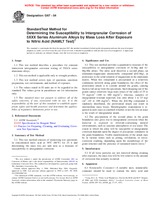Wir benötigen Ihre Einwilligung zur Verwendung der einzelnen Daten, damit Sie unter anderem Informationen zu Ihren Interessen einsehen können. Klicken Sie auf "OK", um Ihre Zustimmung zu erteilen.
ASTM G67-04
Standard Test Method for Determining the Susceptibility to Intergranular Corrosion of 5XXX Series Aluminum Alloys by Mass Loss After Exposure to Nitric Acid (NAMLT Test) (Withdrawn 2013)
Automatische name übersetzung:
Standard Test Methode zur Bestimmung der Anfälligkeit für interkristalline Korrosion von 5xxx Serie Aluminiumlegierungen durch Massenverlust nach der Einwirkung von Salpetersäure ( NAMLT Test) (Withdrawn 2013)
NORM herausgegeben am 1.5.2004
Informationen über die Norm:
Bezeichnung normen: ASTM G67-04
Anmerkung: UNGÜLTIG
Ausgabedatum normen: 1.5.2004
SKU: NS-57779
Zahl der Seiten: 3
Gewicht ca.: 9 g (0.02 Pfund)
Land: Amerikanische technische Norm
Kategorie: Technische Normen ASTM
Die Annotation des Normtextes ASTM G67-04 :
Keywords:
5xxx aluminum alloys, aluminum alloys, grain boundary sensitization, intercrystalline corrosion, intergranular corrosion, mass loss, nitric acid, pitting corrosion, ICS Number Code 77.040.30 (Chemical analysis of metals), 77.120.10 (Aluminium and aluminium alloys)
Ergänzende Informationen
| Significance and Use | ||||
|
This test method provides a quantitative measure of the susceptibility to intergranular corrosion of Al-Mg and Al-Mg-Mn alloys. The nitric acid dissolves a second phase, an aluminum-magnesium intermetallic compound (βAl-Mg), in preference to the solid solution of magnesium in the aluminum matrix. When this compound is precipitated in a relatively continuous network along grain boundaries, the effect of the preferential attack is to corrode around the grains, causing them to fall away from the specimens. Such dropping out of the grains causes relatively large mass losses of the order of 25 to 75 mg/cm2 (160 to 480 mg/in2), whereas, samples of intergranular-resistant materials lose only about 1 to 15 mg/cm2 (10 to 100 mg/in2). When the βAl-Mg compound is randomly distributed, the preferential attack can result in intermediate mass losses. Metallographic examination is required in such cases to establish whether or not the loss in mass is the result of intergranular attack. The precipitation of the second phase in the grain boundaries also gives rise to intergranular corrosion when the material is exposed to chloride-containing natural environments, such as seacoast atmospheres or sea water. The extent to which the alloy will be susceptible to intergranular corrosion depends upon the degree of precipitate continuity in the grain boundaries. Visible manifestations of the attack may be in various forms such as pitting, exfoliation, or stress-corrosion cracking, depending upon the morphology of the grain structure and the presence of sustained tensile stress.3 |
||||
| 1. Scope | ||||
|
1.1 This test method describes a procedure for constant immersion intergranular corrosion testing of 5XXX series aluminum alloys. 1.2 This test method is applicable only to wrought products. 1.3 This test method covers type of specimen, specimen preparation, test environment, and method of exposure. 1.4 The values stated in SI units are to be regarded as the standard. The values given in parentheses are for information only. This standard does not purport to address all of the safety concerns, if any, associated with its use. It is the responsibility of the user of this standard to establish appropriate safety and health practices and determine the applicability of regulatory limitations prior to use. |
||||
| 2. Referenced Documents | ||||
|
Empfehlungen:
Aktualisierung der technischen Normen
Wollen Sie sich sicher sein, dass Sie nur die gültigen technischen Normen verwenden?
Wir bieten Ihnen eine Lösung, die Ihnen eine Monatsübersicht über die Aktualität der von Ihnen angewandten Normen sicher stellt.
Brauchen Sie mehr Informationen? Sehen Sie sich diese Seite an.




 Cookies
Cookies
